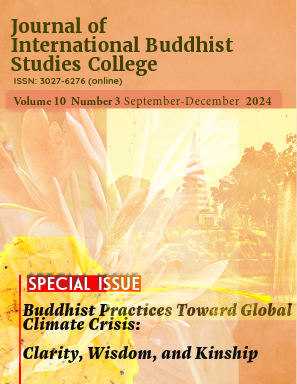A Buddhist Response to Family Conflict: A Study of Sujātā Sutta
Main Article Content
Abstract
This article explores the Buddha’s teachings as a framework for resolving family conflicts, particularly between husbands and wives, to foster household happiness and promote broader societal harmony. Based on the Sujātā Sutta in the Aṅguttara Nikāya, this research identifies four primary sources of family conflict: heavy responsibilities, sexual issues, financial pressures, and mistrust among family members. These conflicts are viewed as natural outcomes of human attachment to the physical world and the influence of craving, emotional distress, and attachment on mental faculties.
The Sujātā Sutta introduces the concept of seven types of wives, categorizing them into two broad groups: those who exacerbate conflicts (slayer-wife, robber-wife, and mistress-wife) and those who cultivate harmony (motherly-wife, sisterly-wife, friendly-wife, and handmaid-wife). The latter four represent virtuous archetypes, exemplifying care, affection, friendship, and devotion. The motherly-wife nurtures her husband as a mother does her child, safeguarding the family’s well-being; the sisterly-wife treats her partner with respectful affection, akin to that between siblings; the friendly-wife approaches her spouse as a trusted friend, fostering love and companionship; and the handmaid-wife exemplifies patience and obedience, maintaining peace within the family.
By recognizing and embracing these virtuous roles, family members, especially spouses, can mitigate conflicts and strengthen familial bonds. This study provides a detailed analysis of the Sujātā Sutta’s teachings, offering practical insights into the Buddhist approach to addressing familial discord. It highlights the importance of mutual understanding, ethical conduct, and emotional intelligence in resolving conflicts, contributing to personal and societal well-being. The findings underscore the relevance of Buddhist wisdom in contemporary family dynamics, presenting it as a timeless guide for cultivating harmony and stability.
Article Details
The Journal of TCI is licensed under a Creative Commons Attribution-NonCommercial-NoDerivatives 4.0 International (CC BY-NC-ND 4.0) licence unless otherwise stated. Please read our Policies page for more information on Open Access, copyright and permissions.
References
Antman, F. M., Kalsi, P. & Lee, S. (2021). Gender norm conflict and marital outcomes. Journal of Demographic Economics, 87(4):537-560. https://doi/10.1017/DEM.2021.7
Barash, D. P., & Lipton, J. E. (2011). How Women Got Their Curves and Other Just-So Stories: Evolutionary Enigmas. Columbia University Press.
Bhikkhu Bodhi. (2003). The Connected Discourses of the Buddha: A New Translation of the Saṃyutta Nikāya. Wisdom Publications.
Bhikkhu Bodhi. (2005). In the Buddha’s Words: An Anthology of Discourses from the Pāli Canon. Wisdom Publications.
D’Antonio, W. V. & Aldous, A. (ed.). (1983). Family and Religion: Conflict and Change in Modern Society. Sage Publication.
Davids, R. (2006). The Book of the Gradual Sayings (Anguttara Nikaya) Vol. 1. The Pali Text Society.
Dhammananda, K. S. (2005). A happy married life: A Buddhist perspective. https://www. Accesstoinsight.org/lib/authors/dhammananda/marriage.Html# ch3
Friedline, T., Chen, Z., & Morrow, S. P. (2021). Families’ financial stress & well-being: The importance of the economy and economic environments. Journal of Family and Economic Issues, 42, 34-51.
Hanh, T. N. (2002). Teachings on love. Parallax Press.
Hanh, T. N. (2010). Peace is every step: The path of mindfulness in everyday life. Random House.
Hare, E. M. (tr.). (1995). The Book of the Gradual Sayings (Anguttaranikāya). vol III. PTS
Harper, D. (2024). Online Etymology Dictionary. http://www.etymonline.com/index.php? allowed_in_frame=0&search=conflict
Harris, B. S. W. S., & Wertz, S. S. (2022). Racial differences in economic security: the racial wealth gap. US Department of the Treasury, 15.
Hünteler, B. (2022). A new perspective on the generational structures of families–Generational placements over the life course. Advances in Life Course Research, 51, 100450.
Ven. Pategama Gnanarama. (2000). Essentials of Buddhism. Pategama Gnanarama Publication.
Pew Research Center. (2023). Economic inequality and family dynamics: Trends and implications. https://www.pewresearch.org
Siegel, D. J. (2010). The Mindful Therapist: A Clinician's Guide to Mindsight and Neural Integration (Norton Series on Interpersonal Neurobiology). WW Norton & Company.
Sinclair, John (ed.). (1992). English Language Dictionary. Harper Collins.
U Ja Ti La. (2018). An Analytical Study of Buddhist Social Roles of Citizen Based on Sigālovāda Sutta. The Journal of International Association of Buddhist Universities (JIABU), 11(2), 200-218.
Pew Research Center. (2023). Economic inequality and family dynamics: Trends and implications. https://www.pewresearch.org
Copur, Z., & Eker, I. (2014). The relationship between financial issues and marital relationship. International Journal of Arts & Sciences, 7(5), 683.


